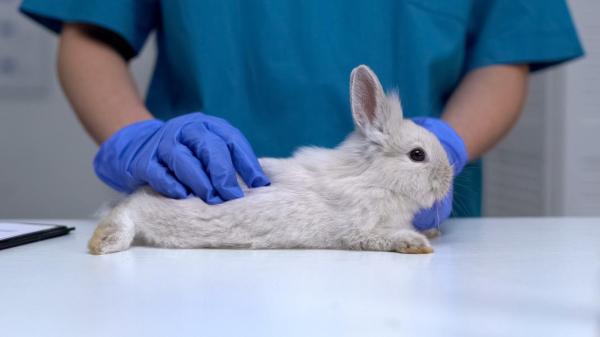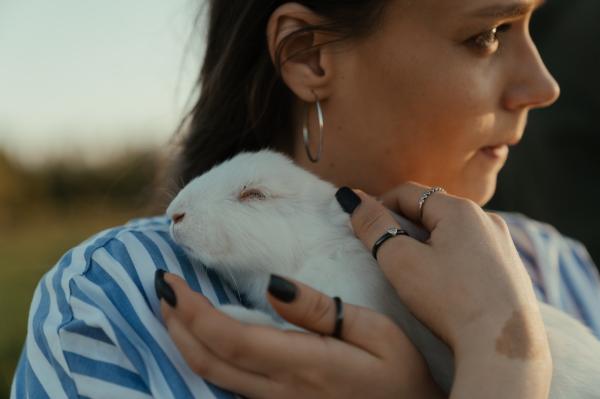My Rabbit Won't Urinate Anymore



See files for Rabbits
Healthy urination is a sign of a healthy rabbit. When they have trouble urinating, it implies their health is at risk. If a rabbit stops peeing altogether, it means you need to take them to a veterinarian immediately. The reasons for a lack of urination in rabbits are varied, but they can be perenal (the problem occurs before the kidneys in the urinary tract), renal (the kidneys are the problem) or postrenal (the issue occurs after urine has left the kidneys). If we act with urgency, we provide a better chance of effective treatment.
At AnimalWised, we understand why my rabbit won't urinate anymore. We look at the underlying causes, as well as what possible treatment options are available.
Rabbit urinary system
The urinary system of rabbits is very similar to that of carnivores. It is made up of two kidneys, two ureters, a urine bladder and a urethra.
The kidneys are relatively large, dark in color and have a smooth surface. The right kidney is more cranial (anterior) than the left and both are located laterally in the retroperitoneal space of the abdomen. In some individuals, the kidneys are surrounded by a large amount of fat that can displace them ventrally. It should be noted that the kidneys of rabbits play a fundamental role in calcium metabolism since they are capable of excreting or conserving calcium according to their metabolic needs.
The ureters are two fine tubes that carry urine from the kidneys to the urinary bladder. The urinary bladder is located in the caudal area of the abdomen, supported by the middle vesical ligament. It is large, with thin walls which allow them to expand. The urethra leaves the bladder, which is responsible for excreting waste outside the body.
We should highlight two important characteristics of rabbit urine:
- Rabbit urine has a cloudy appearance because its alkaline pH level causes the precipitation of calcium, which produces calcium carbonate. It is this calcium carbonate which causes the urine to appear cloudy.
- Occasionally, rabbit urine may have a red hue due to the presence of plant pigments naturally present in their food. This should not be confused with hematuria (presence of blood in the urine). To differentiate it, it will be enough to make a urine strip to detect the presence of blood.
Why has may rabbit stopped peeing?
To better understand why a rabbit stops peeing, we will define the terms oliguria and anuria. Oliguria is a decrease in diuresis (urine excretion) and anuria is a total arrest of diuresis. Therefore, when a rabbit urinates little or not at all, we will say that it presents oliguria or anuria, respectively.
Both oliguria and anuria are clinical manifestations that accompany certain alterations or pathologies of the urinary system. These alterations can include:
- Prerenal (before the kidneys): any factor that decreases the flow of blood to the kidney will decrease the amount of blood filtered by the kidney. Consequently, the amount of urine produced will be lessened. In this case we speak of prerenal azotemia, which is an increase in urea and creatinine due to a problem found before the kidneys.
- Renal (in the kidney itself): the causes of acute kidney injury (AKI) usually present with oliguria (although sometimes the volume of urine may be increased).
- Postrenal (after the kidneys, in the urinary tract): any cause that prevents the elimination of urine to the outside, such as physical obstruction, rupture of the urinary tract or neurological causes, will produce oliguria/anuria. In this case we describe postrenal azotemia, i.e. an increase in urea and creatinine due to a cause that is found after the kidneys in the urinary tract.
We will now look at the causes of urinary problems in rabbits under these three categories.
Hypercalciuria
As we have already mentioned, the presence of calcium carbonate crystals in the urine of rabbits is normal. It is due to the alkalinity which favors the precipitation of calcium. However, when calcium intake in the diet is excessive, it will be eliminated via the kidneys and a calcium carbonate deposit can occur in the urinary bladder. This can result in a large dilation of the organ.
In addition to oliguria or anuria, clinical signs may include:
- Hematuria: presence of blood in the urine.
- Dysuria: difficulty in urination. Urination is usually painful and the rabbit can be seen to adopt a stooped posture.
- Very cloudy urine: if able to urinate, the urine will be much thicker and whiter than normal.
- Weakness: general signs such as depression, anorexia (loss of appetite) and weight loss will likely occur.
- Perineal dermatitis: calcium carbonate deposits in the urine have an irritant action on the skin of the perineum, causing perineal dermatitis, i.e. inflammation of the skin of the perineal area.

Urolithiasis
Urolithiasis is defined as the presence of stones (medically known as uroliths) in the urinary tract. It is a process closely linked to hypercalciuria as uroliths are most commonly made up of calcium carbonate. Hypercalciuria coupled with other factors such as reduced water intake, diets rich in calcium oxalate or changes in urinary pH due to urinary tract infections, favor the formation of stones.
Uroliths can accumulate in the urinary bladder without causing any symptoms, but when they become large enough to obstruct some point of the urinary tract, clinical symptoms will develop. The clinical signs are very similar to those seen in hypercalciuria.
Other causes of urinary tract obstruction
In addition to urolithiasis, there are other processes that can cause obstruction of the urinary tract. As a consequence, the rabbit can no longer urinate. These processes include:
- Adhesions: these are complications that can appear after abdominal cavity surgery, especially when excessive trauma is generated or an inappropriate suture material is used.
- Abscesses: abscesses in rabbits located on tissue within the abdominal cavity (e.g. the mesenteric ganglia) can place external pressure on the urinary tract and cause oliguria/anuria.
- Tumors: as with abscesses, any tumor that affects the organs of the abdominal cavity can also exert external pressure on the urinary tract. Similarly, the presence of a tumor in the urinary tract itself (such as a leiomyoma in the wall of the urine bladder) can reduce the lumen of the ducts and cause a blockage.
- Clots: a blood clot inside the urinary tract can occlude the lumen of the duct and cause a blockage.
When urinary obstruction is maintained over time, the urinary tract can rupture. As a result, there will be leakage of urine into the abdominal cavity (uroabdomen).
Bladder paralysis
This is a pathology of neurological origin. The bladder loses its contractile ability, which prevents urination. As a consequence, there is an excessive dilation of the urinary bladder.
Acute kidney injury (AKI)
Pathologies in which acute nephrological damage occurs will lead to acute kidney injury. Nephrons are the functional unit of the kidney, with each kidney having about one million nephrons. The main causes of AKI in rabbits include:
- Nephrotoxicosis: by drugs, toxins (such as ethylene glycol in car antifreeze) or endogenous pigments (hemoglobin or myoglobin).
- Nephritis: it is a general inflammation of the kidney that can be observed in systemic infectious diseases (encephalitozoonosis, leptospirosis, etc.) or in inflammatory processes (metritis, sepsis, etc.).
- Ischemic necrosis: due to viral hemorrhagic disease.
Prerenal azotemia
As we have already mentioned, any cause that decreases blood flow to the kidney will decrease the volume of filtered blood and, therefore, the volume of urine. The specific causes will be:
- Cardiac pathologies that decrease cardiac output.
- Shock, due to hypovolemia or hypotension.
- Dehydration.
- Renal arterial thrombosis in rabbits it is associated with hemorrhagic viral disease.

What do I do if my rabbit cannot urinate?
First of all, you should know that if your rabbit cannot urinate it is important you go to your veterinarian as soon as possible. In case of oliguria or anuria, an urgent diagnosis can be the difference between life and death. In most cases, the situation is potentially reversible. However, if we do not act quickly and institute early and effective treatment, kidney damage can lead to irreversible kidney failure.
The treatment of each of the causes of anuria will be as follows:
Treatment of post-renal causes
This includes hypercalciuria, urolithiasis, other causes of bladder obstruction or paralysis. In case the urinary bladder is very distended, it is important to drain it via catheterization or bladder puncture to avoid two complications:
Firstly, the rupture of the urinary tract and the consequent uroabdomen. Secondly, the retrograde accumulation of urine in the urinary system, which will reach the kidney and cause hydronephrosis (dilation of the pelvis and renal calyces due to accumulation of urine that causes kidney degeneration). Once the bladder has been emptied of urine, treatment will be started depending on the specific underlying cause.
In the case of hypercalciuria / urolithiasis, the management factors that influenced the onset of the process must be corrected (reduce calcium intake, stimulate exercise and water intake). In addition, analgesics will be administered to ease the pain, diazepam to prevent urethral spasm, bicarbonate to alkalize the urine and, if necessary, antibiotics to treat secondary infections. When the stones cannot be eliminated via the urinary tract with pharmacological treatment, surgical treatment will be necessary to remove them.
Treatment of kidney causes
After having rehydrated the animal with adequate fluid therapy, diuretics will be administered in order to restore normal diuresis. In addition, the primary cause must be specifically treated.
Treatment of prerenal causes
After the precise diagnosis, an appropriate treatment will be established to increase renal blood flow and achieve reversal of azotemia (fluid therapy to rehydrate, increase blood pressure, etc.).
This article is purely informative. AnimalWised does not have the authority to prescribe any veterinary treatment or create a diagnosis. We invite you to take your pet to the veterinarian if they are suffering from any condition or pain.
If you want to read similar articles to My Rabbit Won't Urinate Anymore, we recommend you visit our Other health problems category.
- Rabbit Culture Bulletin. (1991). Diseases of the urinary tract of the rabbit, 53, 28-33
- Vergués, J., & Valls, X. (2014). Clinical cases of exotic animals. Editorial Servet






